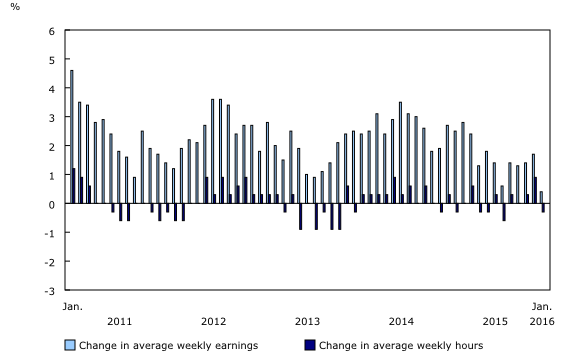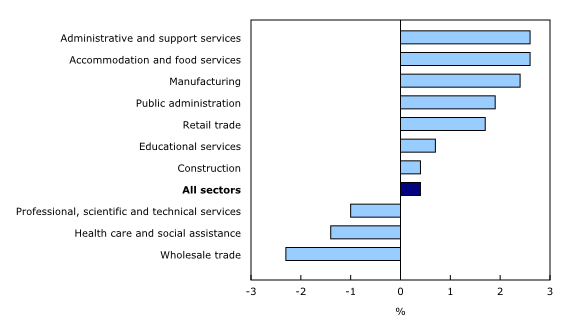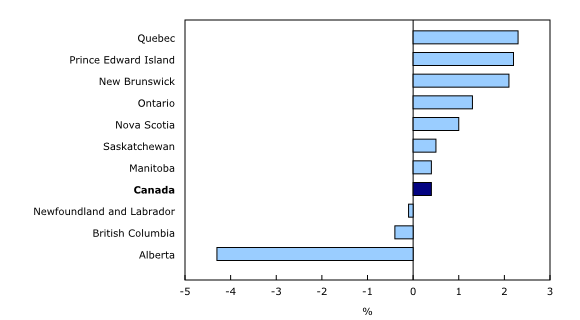Payroll employment, earnings and hours, January 2016
Archived Content
Information identified as archived is provided for reference, research or recordkeeping purposes. It is not subject to the Government of Canada Web Standards and has not been altered or updated since it was archived. Please "contact us" to request a format other than those available.
Released: 2016-03-31
$952.86
January 2016
0.4% 
(12-month change)
Average weekly earnings of non-farm payroll employees were $953 in January, down 0.7% from the previous month. Compared with 12 months earlier, average weekly earnings were little changed (+0.4%).
The change in weekly earnings reflects a number of factors, including wage growth, changes in the composition of employment by industry, occupation and level of job experience, and average hours worked per week.
Non-farm payroll employees worked an average of 32.9 hours per week in January, down from 33.3 hours in December and 33.0 hours in January 2015.
Average weekly earnings by sector
From January 2015 to January 2016, average weekly earnings increased in 5 of the 10 largest industrial sectors, led by administrative and support services, accommodation and food services, and manufacturing. At the same time, earnings declined in wholesale trade and health care and social assistance.
Compared with 12 months earlier, earnings in administrative and support services rose 2.6% to $785. Most of the growth was in employment services, such as agencies referring and placing applicants in employment. Earnings in administrative and support services have been on an upward trend since September 2014.
Average weekly earnings in accommodation and food services increased 2.6% to $384 compared with January 2015. The increase was greatest in full-service restaurants and limited-service eating places.
In manufacturing, earnings were up 2.4% to $1,064. Much of the year-over-year gain was in Ontario. Earnings growth in the sector was widespread, with notable gains in plastic and rubber products.
Average weekly earnings declined in wholesale trade by 2.3% to $1,149 in the 12 months to January. Earnings in the sector have been on a slight downward trend since the spring of 2015. Declines among wholesalers of machinery, equipment and supplies contributed the most to the year-over-year decline.
Earnings in health care and social assistance were down 1.4% to $861 on a year-over-year basis. The most notable decreases were in nursing care facilities, which have been on a downward trend since May 2015.
There was little change in earnings for educational services, construction, and professional, scientific and technical services.
Average weekly earnings by province
Year over year, average weekly earnings of non-farm payroll employees increased in five provinces in January, with the highest growth in Quebec. At the same time, earnings declined in Alberta and were little changed in Manitoba, Saskatchewan, Newfoundland and Labrador, and British Columbia.
In Quebec, average weekly earnings increased 2.3% to $866, with gains spread across most sectors. The largest contributors were retail trade, construction and manufacturing. Most of the year-over-year earnings growth in Quebec was due to gains in early 2015.
Earnings in Prince Edward Island increased 2.2% to $810 compared with 12 months earlier. Gains were widespread, with the highest growth in professional, scientific and technical services, retail trade, and educational services.
In the 12 months to January, average weekly earnings in New Brunswick were up 2.1% to $865, with widespread gains led by information and cultural industries. On the other hand, there were notable declines in educational services, which partially offset wage growth in other sectors in the province.
Average weekly earnings in Ontario increased 1.3% to $963. The increase was spread across many sectors, driven by growth in manufacturing, finance and insurance as well as information and cultural industries. However, earnings declines were observed in several industries, including health care and social assistance and wholesale trade.
In Alberta, earnings fell 4.3% to $1,121 compared with January 2015—the largest year-over-year decline for the province since comparable data were available beginning in 2001. Part of this was due to the fact that earnings in Alberta peaked in January 2015. Earnings losses were observed in almost all industries on a year-over-year basis. A decrease in the number of employees in the high-earning mining, quarrying, and oil and gas industry contributed the most to the decline in average weekly earnings for the province. There were also notable earnings and employment declines in professional, scientific and technical services.
The earnings declines in Alberta largely offset gains elsewhere in the country.
Non-farm payroll employment by sector
The number of non-farm payroll jobs declined by 10,200 in January, following an increase of 41,700 in December. The largest declines were in retail trade, educational services, and administrative and support services. At the same time, there were more payroll jobs in construction as well as in health care and social assistance.
Compared with 12 months earlier, the number of non-farm payroll employees rose by 136,100 or 0.9%. Over this period, the number of payroll jobs increased the most in health care and social assistance (+47,400 or +2.6%) and accommodation and food services (+31,500 or +2.6%).
Declines were observed in mining, quarrying, and oil and gas extraction, down 30,200 or 13.2% on a year-over-year basis. The bulk of these payroll job losses were in Alberta.
Note to readers
With this release, the Survey of Employment, Payrolls and Hours (SEPH) data series have been historically revised. These revisions were made to a number of industries by province and territory, going back to 2001.The seasonally adjusted data have also been revised, based on the latest seasonal factors, going back to 2001.
SEPH is produced by a combination of a census of approximately one million payroll deductions provided by the Canada Revenue Agency, as well as the Business Payrolls Survey, which collects data from a sample of 15,000 establishments. The key objective of the SEPH is to provide a monthly portrait of the level of earnings and the number of jobs and hours worked by detailed industry at the national, provincial and territorial level.
Estimates of average weekly earnings and hours worked are based on a sample and are therefore subject to sampling variability. This analysis focuses on differences between estimates that are statistically significant at the 68% confidence level. Payroll employment estimates are based on a census of administrative data and are not subject to sampling variability.
Statistics Canada also produces employment estimates from its Labour Force Survey (LFS). The LFS is a monthly household survey, the main objective of which is to divide the working-age population into three mutually exclusive groups: the employed (including the self-employed), the unemployed and those not in the labour force. This survey is the official source for the unemployment rate and collects data on the socio-demographic characteristics of all those in the labour market.
As a result of conceptual and methodological differences, estimates of changes from SEPH and LFS do differ from time to time. However, the trends in the data are quite similar.
Unless otherwise stated, this release presents seasonally adjusted data, which facilitate comparisons by removing the effects of seasonal variations. For more information on seasonal adjustment, see Seasonally adjusted data – Frequently asked questions.
Non-farm payroll employment data are for all hourly and salaried employees, as well as for the "other employees" category, which includes piece-rate and commission-only employees.
Average weekly hours data are for hourly and salaried employees only and exclude businesses that could not be classified to a North American Industry Classification System (NAICS) code.
All earnings data include overtime pay and exclude businesses that could not be classified to a NAICS code. Earnings data are based on gross taxable payroll before source deductions. Average weekly earnings are derived by dividing total weekly earnings by the number of employees.
With each release, data for the current reference month are subject to revision. Data have been revised for the previous month. Users are encouraged to request and use the most up-to-date data for each month.
Real-time CANSIM tables
Real-time CANSIM tables 281-8023, 281-8026, 281-8047 and 281-8063 will be updated on April 14. For more information, consult the document Real-time CANSIM tables.
Next release
Data on payroll employment, earnings and hours for February will be released on April 28.
Products
A summary table is available from the Browse by key resource module of our website. Under Summary tables, choose Subject then Labour.
Job Vacancy Statistics (survey number 5202) from the Survey of Employment, Payrolls and Hours for December are now available in CANSIM.
More information about the concepts and use of the Survey of Employment, Payrolls and Hours is available online in an updated issue of the Guide to the Survey of Employment, Payrolls and Hours (72-203-G), from the Browse by key resource module of our website, under Publications.
An updated issue of the Guide to Job Vacancy Statistics (72-210-G) is also now available.
Contact information
For more information, contact us (toll-free 1-800-263-1136; 514-283-8300; STATCAN.infostats-infostats.STATCAN@canada.ca).
To enquire about the concepts, methods or data quality of this release, contact Andrew Fields (613-951-3551; andrew.fields@canada.ca), Labour Statistics Division.
- Date modified:




